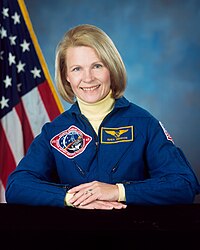Margaret Rhea Seddon
| Rhea Seddon | |
|---|---|

|
|
| Country: | United States |
| Organization: | NASA |
| selected on | January 16, 1978 ( 8th NASA Group ) |
| Calls: | 3 space flights |
| Start of the first space flight: |
April 12, 1985 |
| Landing of the last space flight: |
November 1, 1993 |
| Time in space: | 30d 2h 21min |
| retired on | February 23, 1998 |
| Space flights | |
Margaret Rhea Seddon (born November 8, 1947 in Murfreesboro , Tennessee , USA ) is a former American astronaut . Seddon received a bachelor's degree in physiology from the University of California, Berkeley, and a doctorate in medicine from the University of Tennessee in 1970 .
Seddon practiced general surgery in Memphis.
Astronaut activity
In January 1978, Seddon was selected by NASA as an astronaut candidate. In September 1996, she was preparing medical experiments at Vanderbilt University Medical School, which were launched into space with the Columbia Neurolab mission in April 1998.
STS-41-F
STS-41-F was scheduled for August 1984 with the Discovery. This would have been the Discovery's first flight had it not been canceled due to payload delays. The crew were Karol Bobko, Donald Williams, Rhea Seddon, David Griggs and Jeffrey Hoffman. The flight then became STS-51-E .
STS-51-E
This Challenger flight was canceled due to problems with the IUS upper level. A TDRS satellite should have been deployed. The crew were Karol Bobko, Donald Williams, Rhea Seddon, David Griggs, Jeffrey Hoffman, the French payload specialist Patrick Baudry and the politician Jake Garn .
STS-51-D
On April 12, 1985 Seddon took off as a mission specialist on the space shuttle Discovery for the first time. The payload was the two satellites TELESAT-9 and LEASAT-3 . In the latter, however, the automatic commissioning of the antenna and the engine did not work. Despite an exit from space by astronauts Jeffrey Hoffman and David Griggs , this defect could not be repaired.
STS-71-E
The start of the Atlantis mission STS-71-E / Spacelab SLS-2 would have been planned for April 1987, but was canceled because of the Challenger disaster. In addition to Seddon, crew members for this SLS-1 mission were Vance Brand , David Griggs , John Fabian , James Bagian , Francis Gaffney and Robert Phillips .
STS-40
On June 5, 1991 Seddon started as a mission specialist with the Space Shuttle Columbia for the STS-40 mission . It was the fifth Spacelab mission, the first to focus solely on the life sciences. The most important experiment was Spacelab Life Sciences-1. Physiological studies were carried out on humans, 30 rodents and thousands of tiny jellyfish. Of the 18 studies, ten dealt with humans, seven with rodents and one with jellyfish.
STS-58
On October 18, 1993 Seddon took off as a mission specialist on the space shuttle Columbia into space . This was the Spacelab mission SLS-2 and served to research the effects of weightlessness on the human body. The landing took place at Edwards Air Force Base .
According to NASA
In November 1997, Seddon retired from NASA and became Assistant Chief Medical Officer of Vanderbilt Medical Group in Nashville, Tennessee.
Honors
Seddon was inducted into the Astronaut Hall of Fame in 2015 .
Private
Rhea Seddon is married to astronaut Robert Gibson and has three children.
See also
Web links
- Short biography of Margaret Rhea Seddon at spacefacts.de
- NASA biography of Margaret Rhea Seddon (PDF)
- Biography of Margaret Rhea Seddon in the Encyclopedia Astronautica (English)
Individual evidence
- ↑ Space Coast Daily: NASA Inducts Four Heroes Into US Astronaut Hall Of Fame. June 1, 2015, accessed June 3, 2015 .
| personal data | |
|---|---|
| SURNAME | Seddon, Margaret Rhea |
| BRIEF DESCRIPTION | American astronaut |
| DATE OF BIRTH | November 8, 1947 |
| PLACE OF BIRTH | Murfreesboro (Tennessee) , Tennessee, USA |